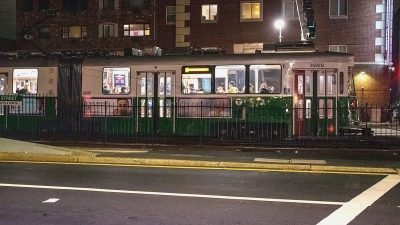
Reid Phillips stood on Commonwealth Avenue and watched a Green Line train rolling down the tracks towards her stop. She looked down at her phone — she was going to make it to class.
To her surprise, the College of General Studies sophomore also watched the T continue rolling right past the Boston University West stop. Phillips sighed — she was going to be late to FT 201 again.
Philips, like many BU students, was an unknowing subject of an MBTA schedule adjustment, meant to maintain equal distances between trains and prevent overcrowding, Joe Pesaturo, director of communications for the MBTA, wrote in an email.
“MBTA dispatchers have to make schedule adjustments from time to time,” Pesaturo wrote. “These are strategic, targeted schedule adjustments that are necessary to prevent trains from ‘bunching.’”
Trains are sometimes directed to skip stops to prevent this “bunching” and those waiting to board will have to wait for the next train’s arrival, Pesaturo wrote.
“When trains are too close together, dispatchers sometimes will direct the operator of the lead train to bypass some stops in order to adjust the spacing between trains,” Pesaturo wrote. “Customers who are on the platforms that are bypassed are able to board the next trains, which typically arrive a very short time later.”
Pesaturo wrote these adjustments occur infrequently and only when necessary and are dependant on conditions caused by motor vehicle traffic on Commonwealth Avenue. Additionally, the MBTA is investing tens of millions of dollars to improve service on the B Line, according to their website.
These improvements include the installation of new track, twenty-four new trolley cars and the consolidation of stops that are close together. However, at present, these schedule adjustments remain a common occurrence for BU students.
Charlie Ticotsky, the policy director for Transportation for Massachusetts, said that while the adjustments are inconvenient, they are necessary.
“I know it can be frustrating to riders to see a train go by and not stop,” Ticotsky said. “I think there is room for improvement in terms of dispatch but that is the reality of running an old trolley system that crosses streets and has a lot of physical limitations.”
Ticotsky said the T stops on BU’s campus are especially prone to schedule adjustments because of the inconsistencies in spacing.
Ticotsky said while students may be frustrated that there’s no way of knowing if a train will go express or not, the MBTA has made improvements in communication overall.
“There is always room for improvement and there will always be some times that riders are frustrated, but I think that they have definitely made a concerted effort to do a better job,” Ticotsky said.
The MBTA is also looking to reduce the bypassing issue by giving trains and buses longer green lights, Ticotsky said.
“That should definitely help with consistency and cut down on the times that they are forced to go express,” Ticotsky said.
Amy Arellano, a senior in Sargent College of Health and Rehabilitation Services, said that bypassing is not a huge problem until the T takes you far off campus.
“If the stops are close in distance — like here the stops are pretty close together on the Green Line — I think it is O.K. because then you will only have to walk a little bit,” Arellano said. “But I guess for stops that are farther apart then I don’t think that is okay because you might be on a time crunch and can’t be dropped off somewhere else.”
Sabrina Woo, a senior in the College of Communication, said she has also experienced the T’s schedule adjustments.
“I have had the T go and suddenly become an express train and go right across campus and take me all the way to Packards Corner or Harvard Ave,” Whoo said, “which is annoying because then you have to get off and walk to your stop or wait for the T.”
Phillips said she wants more communication from the MBTA and third-party sources of public transportation information, such as the app ProximiT, which shows the location of T trains in real time.
“My ideal suggestion for this would be on the app [ProximiT] if there was some type of notification that the train was express,” Phillips said. “That is usually where I see where the T is, so it would be nice to know if it was not going to stop where I was at.”
Gabriel Klavans, a junior in the College of Arts and Sciences, said he thinks the MBTA should let people know when a train is going express.
“The train bypassing was annoying,” Klavans said. “It just looked like a train was coming … I thought that was weird that there was absolutely no indication that it was an express train on any sort of live update thing.”
Correction: A previous version of this article did not include the fact that the MBTA is working on giving T trains longer green lights at intersections, therefore putting the following quote from Charlie Ticotsky out of context. The current version reflects these changes.
















































































































